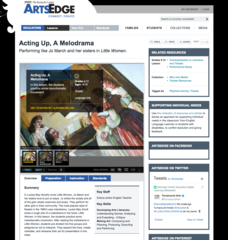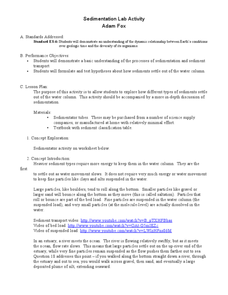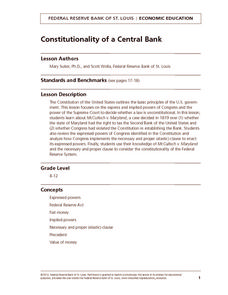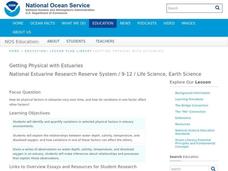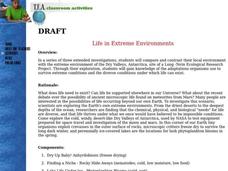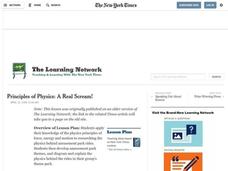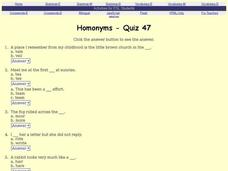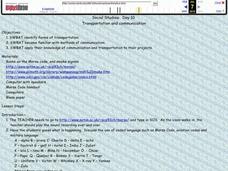Curated OER
Afghanistan: People, Places and Politics
Learners discuss their prior knowledge of Afghanistan. They work together to complete a study guide about Afghanistan's people and places. They present their information to the class.
Curated OER
Music Makers
Students explore distinct styles that have characterized famous musicians and conductors. By studying one musician or conductor in-depth, students become experts on this person's musical style and are given the opportunity to share.
Curated OER
Great Lakes Ecology
Students are able to use a secchi disk to measure the turbidity of water by determining the depth at which the sechi disk is no longer visible and using the data in a formula to quantify the results. They are able to use Vernier probes...
Curated OER
Getting into Hot Water
Students discuss the effect of global warming on bodies of water after reading "An Icy Riddle as Big as Greenland" from The New York Times. Students work in groups to research topics related to global warming and Greenland's ecology...
Curated OER
Terrible Things
Students reflect on the Holocaust in two lessons. Using prior knowledge, they investigate and make decisions dealing with human behavior before beginning their studies on the Holocaust. After examining different aspects of the event,...
John F. Kennedy Center
Acting Up, A Melodrama: Performing Like Jo March and Her Sisters in Little Women
Lights, Camera, Action! Pupils read Little Women and create, act, and direct a melodrama that Jo March and her sisters would enjoy. The lesson plan comes complete with resources for the educator on melodrama as well as examples...
Curated OER
Sedimentation Lab Activity
Students predict how sediments in a water column will settle. In this earth science lesson, students examine the layers of sedimentation. Students are given sediments to place into a column of water and observe how they settle....
Royal Society of Chemistry
Units of Volume
Did you know in the UK a quart is smaller than in America? This explains why a standard unit of measure is necessary for volume. Young scientists learn the similarities and differences between five different units used to measure volume....
Curated OER
My Antonia: K-W-H-L Strategy
Use the well-known KWHL chart as a tool for building up to a research project and oral presentation related to Willa Cather's My Antonia. Starting with a class brainstorm, pupils research and gradually narrow down topics relating to...
Illustrative Mathematics
Sand Under the Swing Set
Help the local elementary school fix their playground by calculating the amount of sand needed near the swing set. The problem practices setting up proportions and ratios with three different options for solving. You can chose the option...
Federal Reserve Bank
Constitutionality of a Central Bank
Considering the expressed and implied powers of Congress, was it constitutional for the United States to establish the Second National Bank in the early nineteenth century? What is the constitutionality of the Federal Reserve...
NOAA
A Quest for Anomalies
Sometimes scientists learn more from unexpected findings than from routine analysis! Junior oceanographers dive deep to explore hydrothermal vent communities in the fourth lesson in a series of five. Scholars examine data and look for...
Curated OER
Contour Drawing
Students create a contour drawing of a hand creating an illusion of depth. After a brief demonstration of contour drawing, students practice by creating pictures of various objects. The final project consists of creating a contour...
Heritage Foundation
The House of Representatives
The House of Representatives has a lot of responsibility in the United States government. But how did it all begin, and why is it the way it is now? A comprehensive lesson plan answers all of these questions about the US...
Curated OER
Atlantic Canada Report
Ninth graders create a report that will show an in-depth knowledge of the various geographical and climatic features of Atlantic Canada. They produce various items, on paper and using the computer, to demonstrate knowledge of outcomes,...
Curated OER
La Toteca- A Tropical Paradise
Students collect data on the time of the ferry. In this algebra lesson, students use the data to predict a ferry schedule. They also compute the depth where oxygen would be needed when diving.
Curated OER
International Food
Learners creatively develop a project dealing with a country of their choice. They gain knowledge of other cultures through research. Students develop an essence of food customs and traditions of the country of their choice. They design...
Curated OER
Getting Physical with Estuaries
Students study estuaries and how the physical factors change over time. In this investigative lesson students use a website to gain knowledge of estuaries then in groups they create and present their charts.
Curated OER
Life in Extreme Environments
Students compare and contrast local environments with the extreme environment of the Dry Valleys, Antarctica. Students explore and gain knowledge of the adaptations organisms use to survive extreme conditions and the diverse conditions...
Curated OER
Principles of Physics: A Real Scream!
Students apply their knowledge of the physics principles of force, energy and motion to researching the physics behind amusement park rides.
Curated OER
Formulae
Young scholars, after reviewing the concept of simply counting, practice a variety of equations that address operations. They utilize the strategy of substitutions in additional practice problems. Algebraic expressions is also covered in...
Curated OER
Homonyms -- Quiz
In this grammar activity, students are assessed on their knowledge of homonyms. Students choose a homonym to complete the sentence.
Curated OER
Transportation and Communication
Learners take an in depth look at communication. In this communication lesson, students discuss the effectiveness of codes, languages, and transportation in communication. Learners participate in a problem solving activity that requires...
Alabama Learning Exchange
Ellipse
Students explore the concept of ellipses. In this ellipses lesson, they construct ellipses on their paper and follow directions on a worksheet that allow them to investigate an ellipse in more depth by looking at the major axis, foci, etc.





